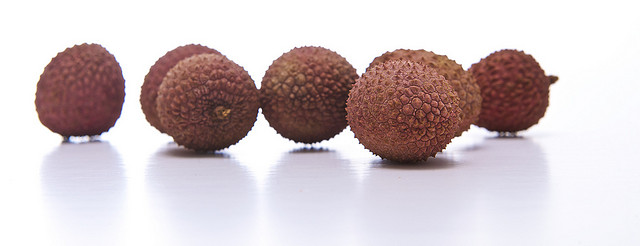
Experienced lychee eaters bite lightly through the skin of the top and then squeeze the fruit out. Photo © THOR, licensed Creative Commons Attribution.
Jackfruit, carambola, mamey sapote, sapodilla, lychee, longans, pineapple, and papaya are the kinds of fruits you imagine eating on a far-flung tropical island. Fling a little closer, and you’ve got Pine Island. Just west of Cape Coral, it is the largest island along the southwest coast of Florida and the producer of some of the state’s most exotic fruits. Not the usual Florida orange, Pine Island’s king of fruits is the mango. Its reign is so celebrated that there is an annual two-day festival, the Pine Island MangoMania Tropical Fruit Fair (239/283-0888) in July with mango-inspired foods, entertainment, and lots of fragrant fruits and plants for sale. You may not want to bother with jackfruit, but check out the rest of Lee County’s tropical bounty.From late May to about Labor Day, enthusiasts can also stop into the tent-covered Pine Island Tropical Fruit Market in Bokeelia (10 a.m.–4 p.m. Fri.–Sun.) for a wide array of tropical fruits. The Fort Myers Downtown Farmers’ Market in Centennial Park offers a fair sampling of the local exotic fruits (7 a.m.–2 p.m. Thurs.). Even the local Eden Vineyards applauds the local fruits with one of its wines, made from carambola.
But what is a carambola, exactly?
Carambola is another word for starfruit, that light yellow, ribbed, ovoid fruit that, when sliced, has star-shaped cross-sections. The flesh is yellow, crisp, juicy, and not fibrous, ranging from very sour to mildly sweet.
Mamey sapote is a large, football-shaped fruit that grows on an ornamental evergreen. The brown skin has a rough texture—rougher than a kiwi. The flesh is either creamy pink or salmon color, and it has a big avocado-like pit. The flavor is described as a combination of honey, avocado, and sweet potato. Closely related, the sapodilla has soft brown flesh that tastes a little like very sweet root beer. The sapodilla tree is also the source of chicle, a chewing gum component.
Lychee are nubby red fruits with pearly white flesh and the texture of a grape. The flesh is sweet but tart, and with a very strong scent. Experienced lychee eaters bite lightly through the skin of the top and then squeeze the fruit out. The longan is known as the little brother of the lychee. They look alike, only the longan is smaller. The flesh is whitish and translucent like the lychee, but less strong smelling and a little muskier.
Jackfruit is the fruit for the intrepid. It is the largest tree-borne fruit in the world, up to 80 pounds, and the unopened fruit has a strong, disagreeable smell. The exterior is spiky and green, and the inside has large edible bulbs that taste like a cross between banana and papaya. You may not want to bother with jackfruit, but check out the rest of Lee County’s tropical bounty.
Excerpted from the Fourth Edition of Moon Florida Gulf Coast.